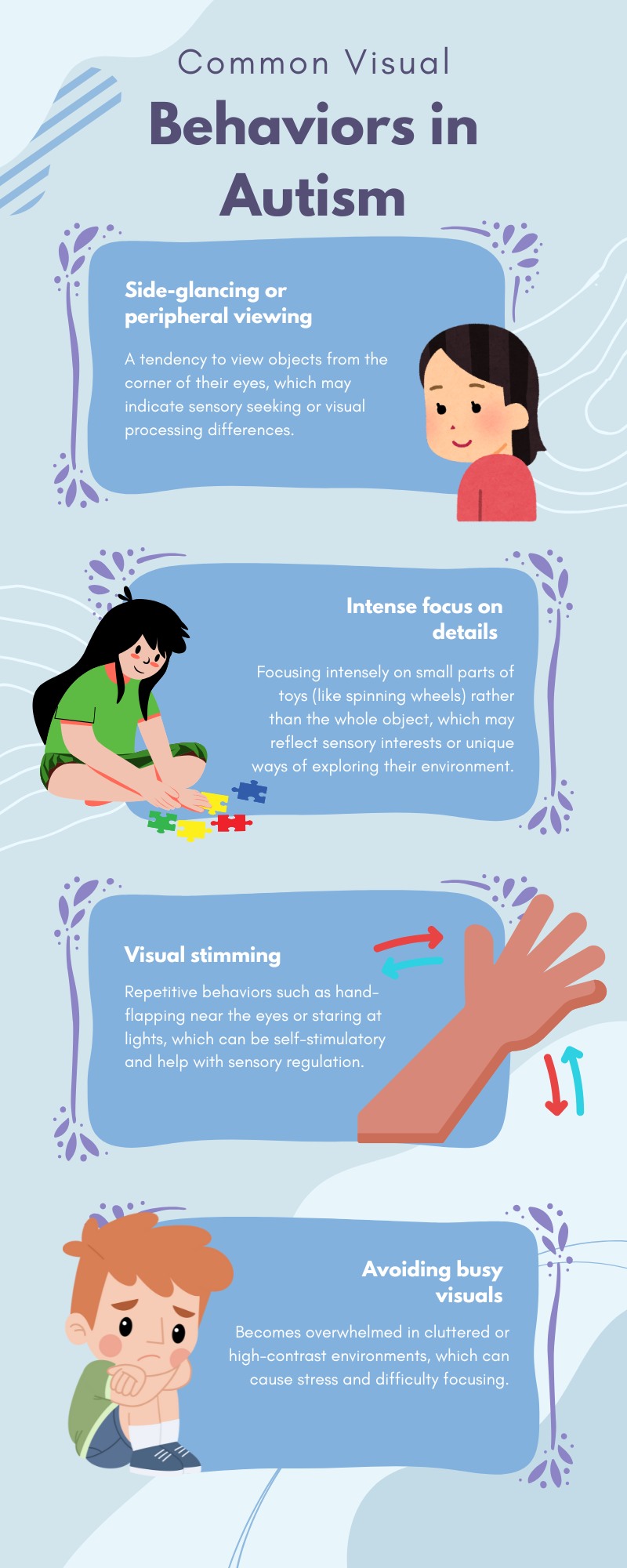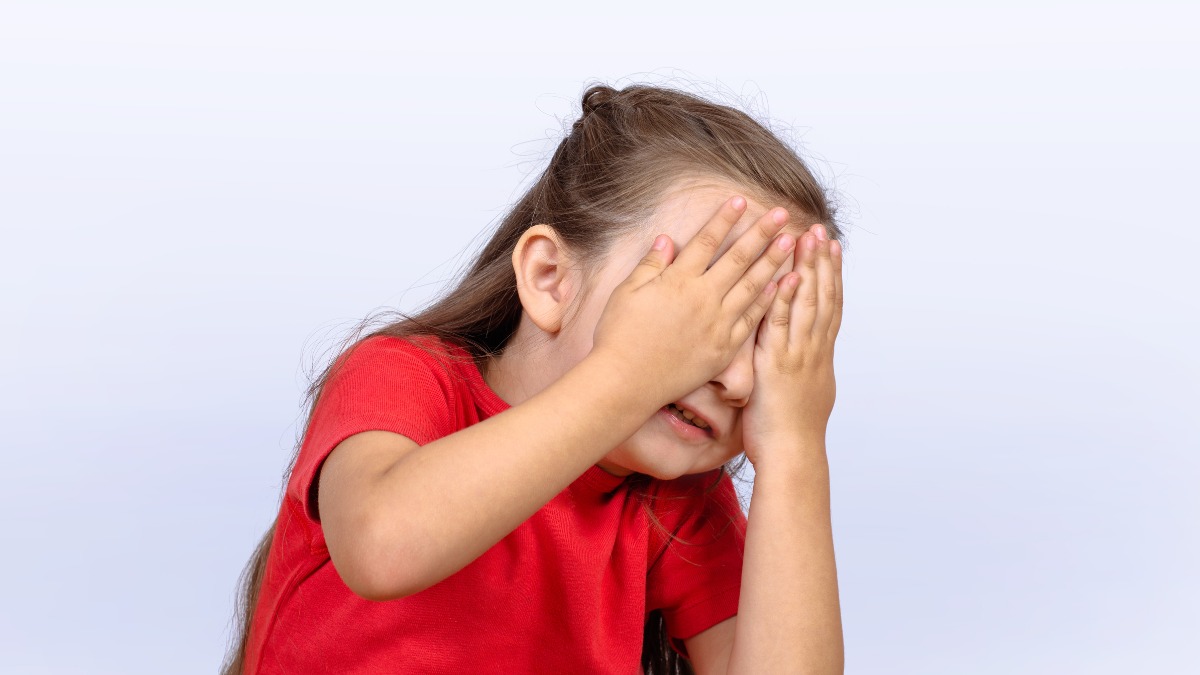Key Points:
- Many children with autism experience visual autism symptoms, including light sensitivity, difficulty with eye contact, and unusual focus on specific visual details.
- These vision-related challenges can affect learning, social interactions, and daily functioning.
- Early recognition and supportive strategies can help improve visual processing and overall comfort.
As a parent, you know when something’s different about how your child sees the world. Maybe they track moving objects oddly or get lost in visual details. These visual autism symptoms are more common than you might think – and recognizing them can open doors to better support.
What are the Visual Autism Symptoms to Watch For?
Visual autism symptoms may include avoiding eye contact, staring at spinning objects, or becoming distressed by bright lights. These behaviors aren’t just quirks; they’re signs of how the brain processes visual information differently.
Some children may also struggle with tracking moving objects or focusing on faces, which can impact social communication. Recognizing these signs early can help you provide better support and seek appropriate interventions.
How Autism Affects Visual Processing
You’ve noticed your child’s unique reactions to visual stimuli – but what’s actually happening in their brain? Let’s explore the neurological reasons behind these visual autism symptoms, and how they impact your child’s daily experiences in ways you might not expect.
Sensory Overload and Light Sensitivity
Many children with autism experience heightened sensitivity to light, patterns, or colors—a condition known as photophobia. Fluorescent lighting, flashing screens, or even sunlight can feel overwhelming, leading to squinting, headaches, or avoidance behaviors.
Difficulty with Eye Contact and Facial Recognition
Eye contact can feel intensely uncomfortable for some individuals with autism. Research suggests this isn’t due to disinterest but rather an overstimulating sensory experience. Additionally, some may struggle to recognize faces or interpret facial expressions, making social interactions more challenging.
4 Common Visual Behaviors in Autism
Wondering what specific signs to look for? Here are some of the most frequently observed visual autism symptoms:

While every child is unique, these behaviors often signal differences in visual processing that may need attention.
The Link Between Vision and Learning Challenges
What looks like disinterest in reading or writing might actually be your child struggling to process visual information. Let’s explore how these vision challenges connect to classroom difficulties, and most importantly, what can help.
Reading and Writing Difficulties
Visual processing differences can make reading exhausting. Some children may skip words, lose their place, or struggle with letter recognition. Others might write letters backward or have trouble organizing words on a page.
Depth Perception and Coordination Issues
Catching a ball or judging distances can be harder for kids with visual autism symptoms. These challenges often stem from delays in depth perception or hand-eye coordination, which occupational therapy can help address.
Supporting Your Child’s Visual Needs
Every child experiences visual autism symptoms differently, which means solutions need to be just as personalized. The good news is that small changes in daily life can create big improvements in comfort and confidence.
Lighting, for example, makes a huge difference for sensitive eyes. Try replacing harsh fluorescent bulbs with softer, natural light options whenever possible. This simple switch can immediately reduce discomfort and anxiety.
Clutter can also be visually overwhelming for children with autism. Keeping play areas and workspaces clean and organized helps minimize distractions. Focus on creating simple, calming spaces where your child can focus.
Picture-based social stories are wonderful tools as well for explaining daily routines. Reading can also be easier with large-print books. The clearer visual presentation helps children focus on the content without straining their eyes. Similarly, sensory activities like those explored in 7 Benefits of Kinetic Sand for Autism Support can engage multiple senses, enhancing focus and making learning experiences more enjoyable and effective.
When to Seek Professional Help
If your child’s visual autism symptoms begin disrupting their daily routine, it may be time to consult a specialist. Signs like consistently avoiding school due to bright lights, difficulty recognizing family members, or extreme distress in visually busy environments should not be ignored.
A developmental optometrist can evaluate how your child processes visual information. They specialize in vision-related challenges that go beyond typical eye exams. Occupational therapists can also help, particularly with sensory integration and developing coping strategies.
These professionals will assess your child’s needs and create a personalized plan. Early intervention often leads to better outcomes, helping your child navigate their world with greater comfort and confidence.
Work with Empower ABA: Building Skills for Brighter Futures
While ABA therapy doesn’t treat vision directly, it helps children develop coping strategies for sensory sensitivities. At Empower ABA, our therapists work on skills like:
- Gradually increasing tolerance to eye contact.
- Using visual supports to improve communication.
- Managing reactions to overwhelming stimuli.
If your child’s visual autism symptoms are affecting their growth, Empower ABA can help. Our team creates personalized ABA programs in Virginia, New York, and New Jersey. Contact us today to learn how we can support your child’s journey toward confidence and independence.
By combining professional guidance with at-home strategies, you can help your child navigate their visual world with greater ease. Reach out now to take the first step.

